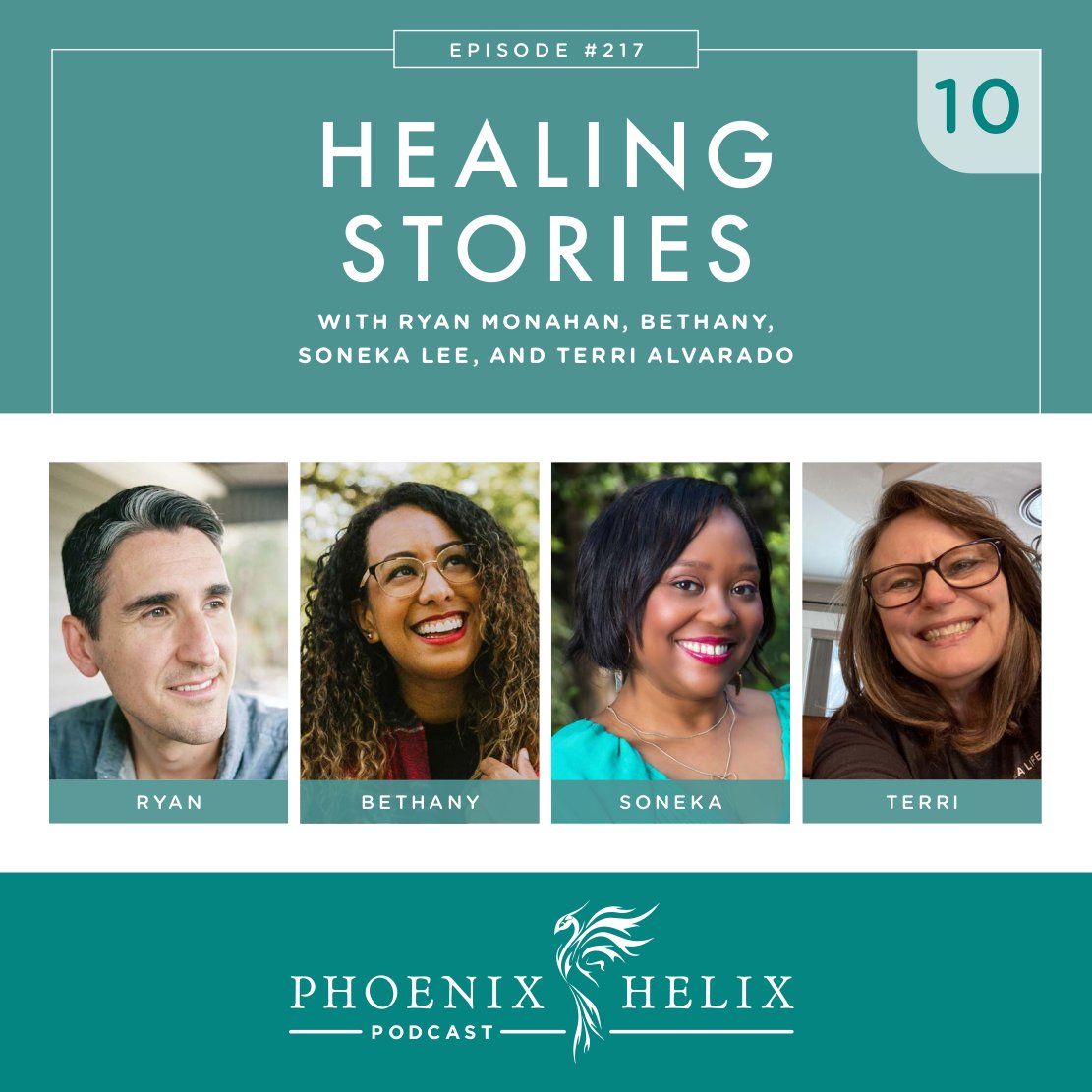Real-Life Stories of Autoimmune Resilience
If you’re a regular listener of my podcast, you know that I start every year with a Healing Stories episode. It features back-to-back interviews with autoimmune warriors just like you! I ask them to share their journey from rock bottom to reclaiming a vital life. In this episode, we talk about Hashimoto’s Thyroiditis, Hidradenitis Suppurativa, Ankylosing Spondylitis, Susac Syndrome, and also autoimmunity in general. Everyone’s story is unique, but we also have so much in common. Whatever your diagnosis, I hope these stories resonate and inspire.
Listen to the Show
- Subscribe to my podcast through your favorite podcast app: iTunes, Google, TuneIn, Spotify, Amazon, etc.
- You can also listen to the episode right here through the player below, and if you subscribe to my newsletter you’ll get notified of future episodes.
Podcast: Play in new window | Download
Show Notes
- Intro (0:00)
- Thank You to Our Podcast Sponsor – ShopAIP (1:37)
- Happy New Year! Many of you are doing an AIP Reset, or trying the Paleo Autoimmune Protocol for the first time. ShopAIP is here to make that easier for you! They sell hundreds of shelf-stable pantry items for the elimination phase and products labeled by reintroduction category as well.
- To give you some examples of what’s available, they sell AIP-friendly spice blends, nightshade-free sauces and condiments, quick proteins like meat bars and canned seafood, cooking and baking ingredients, and they also have a variety of both sweet and salty snacks. They even sell AIP pasta!
- If you’re a first-time customer, use the code PHOENIX for 10% off your order. Purchase here.
- Ryan’s Healing Story (2:45)
- Ryan Monahan has Hashimoto’s, an autoimmune disease that attacks the thyroid gland.
- It took him 15 years to get a diagnosis. As a teenager, he suffered from allergies and asthma. In college, his symptoms expanded to include depression, brain fog, chronic fatigue, edema, and constipation. Doctors told him his symptoms were normal for his age. The entire decade of his 20’s felt like groundhog day, where every day he would wake up exhausted. He struggled to manage his symptoms and saw 40+ doctors and specialists seeking answers.
- It was a doctor who practiced integrative medicine who finally ran a thyroid panel. Ryan was 28 years old. By that point, his thyroid antibodies were in the thousands and his TSH was over 150 (when normal is under 5). He was in an extreme state of hypothyroidism and Hashimoto’s. When he was referred to an endocrinologist for thyroid medication, the endocrinologist told him that antibodies don’t matter, and there was nothing he could do from a diet or lifestyle perspective to improve his condition. The medication did make dramatic improvements almost immediately, but those improvements only lasted a few months before his symptoms returned. That was when he started to look for interventions in addition to the medication.
- It’s been 10 years since his diagnosis, and his life is unrecognizable from his rock bottom. His debilitating symptoms have resolved, and he’s been able to build a life that he loves. He has a thriving career, a loving partner, lives in a beautiful part of the country, spends a lot of time hiking outdoors, and he’s also a musician who is building a recording studio in his home. His health is the foundation that allows him to do all of this. None of this was possible when his symptoms were at their worst.
- The lifestyle changes that have made the biggest difference for him are the AIP diet (with a focus on nutrient density), prioritizing sleep (and balancing his circadian rhythms), stress management (including time for community and laughter), and exercise (which for him includes gentle yoga, hiking, and going for long walks with his dog). He didn’t make all these changes overnight. He educated himself about autoimmune health, changing his knowledge and mindset first, and then slowly changed his habits. It was a big change! His old lifestyle was the opposite of today. He had been eating a Standard American Diet, was sedentary most of the day, stayed up late, and didn’t think about stress management.
- One resource Ryan found especially helpful was the book, Hashimoto’s Protocol by Izabella Wentz. He used it as a guide for improving his own health and found it so helpful that he was inspired to become a functional practitioner himself, so that he could help others.
- You can connect with Ryan through his website: The Mindful Nutrivore. In addition to being an autoimmune warrior, he is a Functional Diagnostic Nutrition Practitioner and Board Certified Health Coach.
- Hashimoto’s Resources:
- Bethany’s Healing Story (20:07)
- Bethany has Hidradenitis suppurativa (HS), an autoimmune disease that causes painful lumps to form under the skin, often in sensitive and private areas like the armpits, inner thighs, groin, buttocks and breasts.
- She started developing symptoms in late 2020 and didn’t know the cause. Her doctor gave her antibiotics which helped, but the symptoms returned. She did a Google search and learned about HS, which was more frightening than comforting. She went to a dermatologist who made the official diagnosis, but antibiotics were the only treatment offered, and they didn’t work for her long-term. That’s when she hit her rock bottom. When her symptoms were at their worst, she was in a lot of pain. Many of the bumps were on her inner thighs, and it hurt to walk. She also experienced joint pain and digestive symptoms. Because HS appears in private parts of the body, it can be hard to talk about. The pandemic already felt isolating, and this left her feeling isolated even more. She felt hopeless.
- When conventional doctors couldn’t help her, Bethany sought help from a naturopath. The first one she found on Google, and her experience was negative. She spent a lot of money for no improvement. She did more research before trying again and found a naturopath who has HS herself. The advice she received from this second naturopath was incredibly helpful. Bethany was vegan at the time, and she changed to low-carb paleo based on the naturopath’s advice. It was very hard at first, but she felt the benefits immediately. She was also prescribed supplements that have been more helpful to her condition than antibiotics. She recommends working with a good practitioner to personalize your protocol, but the supplements that have helped her the most are: microcidin (requires a prescription), probiotics, zinc, vitamin D, and collagen.
- Lastly, Bethany now has a support system and no longer feels alone. She broke the veil of secrecy and opened up to people in her life that she trusts. She found an HS support group where she connects with other people with the same condition. She also worked with a therapist to transform her feelings about her body. At rock bottom, she felt like her body hated her. Now, she knows her body is trying to protect her. She sees her symptoms as messengers about what her body needs for health. She no longer feels like her body is her enemy.
- Her life today is dramatically different from her rock bottom. While she still occasionally has flares, they’re much milder. She has fewer bumps that are smaller and less painful. She can enjoy going for walks again. She can go out with friends with no need to manage chronic pain. Most importantly, she feels empowered. She’s living a fulfilling life.
- I met Bethany through Instagram. You can follow her @KindredSpiritKitchen.
- HS Resources:
- Book: The Hidden Plague.
- Peer-to-Peer Support Group: HS Diet Connection on Facebook.
- Bethany’s Naturopath: Dr. Alison Danby.
- Thank You to Our Podcast Sponsor – Captain Soup (40:53)
- Captain Soup sells nutrient-dense freezer meals, designed specifically to enable the body’s healing. They only use the highest quality ingredients including locally sourced, 100% grass-fed and finished meats, wild-caught seafood, 100% organic vegetables, and bone broth made in-house from the bones and organ meat from the best grass-fed lamb in the world.
- They sell 7 flavors of soup which are paleo, keto, and Wahls protocol-compliant. 5 of those flavors also fit the elimination phase of the Paleo Autoimmune Protocol. 4 of the flavors are Low-FODMAP. And 2 flavors are GAPS-compliant.
- Here are the flavors: Classic Lamb, Dijon Lamb, Italian Beef, Classic Beef, Dijon Beef, Green Machine & Tom Kha. (Tom Kha is a seafood soup that’s available in-season.) They also have the full ingredient list for every flavor on their website.
- You can buy pre-selected variety packs or build your own custom box. They also have a nutrient-dense liver pâté that can be substituted for any soup upon request.
- Order today and get nutrient density delivered to your doorstep! Use the code PHOENIX to save $25 off your first order.
- Soneka’s Healing Story (42:36)
- Soneka Lee has ankylosing spondylitis, an autoimmune disease that attacks the joints of the spine, hips, and shoulders.
- Her symptoms started in 2003, but significantly increased after a car accident in 2017. She suddenly had a constant deep ache in her lower back. It felt like back labor that never went away. Soneka is a physical therapist, so she’s familiar with back injuries caused by accidents, and the pain she was experiencing didn’t match that pattern. She went to multiple doctors, including pain doctors and an orthopedic specialist, but they could find nothing wrong. It was finally her primary care doctor who looked at her x-rays and noticed inflammation in her sacroiliac joint. She referred Soneka to a rheumatologist who ran the blood markers and gene tests that confirmed a diagnosis of ankylosing spondylitis. Untreated ankylosing spondylitis can cause permanent spinal fusion. Soneka has one fusion in the sacroiliac joint, and she also experiences pain in her ligaments and tendons.
- She was prescribed immunosuppressant medication which relieved the deep back pain, but the inflammation in her ligaments and tendons remained. It was still very debilitating. When this pain was at its worst, her physical therapy patients would tell her to sit down and rest during appointments. She also had two young children and feared she wouldn’t be able to take care of them. She started to feel depressed and knew she needed to make a change. She found a Facebook group which talked about a low-starch/low-carb diet for ankylosing spondylitis. She decided to cut rice, potatoes, sugar, and refined foods from her diet, and she felt better immediately. She went from having to crawl up the stairs to her apartment at the end of the workday, to now being able to walk up the stairs pain-free.
- After food, stress is her second biggest inflammation trigger. Whereas inflammatory foods cause pain in her tendons and ligaments, stress causes pain in her sacroiliac joint. So, her body talks to her in different ways. Her favorite stress reliever is dancing. She loves music, and when she’s dancing she can forget about the stress in her life and just enjoy herself. When her pain was at its worst, she couldn’t dance at all. Once she changed her diet, she was able to dance again. That motivates her to stick with her healing diet.
- Soneka’s life today is very different from her rock bottom. At her worst, the pain was so severe that she had to crawl up the stairs of her apartment, and that was a 20 on a scale of 1 to 10. Now, if she has a flare, her pain might reach a 3 at the most, and she has many pain-free days.
- You can connect with Soneka through her Facebook group: Autoimmune Warriors Reclaiming Their Lives with a Holistic Approach. In addition to being an autoimmune warrior herself, Soneka is a doctor of physical therapy and an AIP certified coach. She offers 1:1 coaching services virtually.
- Ankylosing Spondylitis Resources:
- Article: The Great Starch Experiment.
- Peer-to-Peer Support Group: The Low/No Starch Lifestyle for Ankylosing Spondylitis.
- Soneka’s Facebook Group: Autoimmune Warriors Reclaiming Their Lives with a Holistic Approach.
- Terri’s Healing Story (54:40)
- Terri Alvarado has Susac Syndrome, a rare autoimmune disease that attacks the smallest blood vessels in the brain, retina, and inner ear.
- Her symptoms started with vertigo, memory challenges, and an inability to concentrate. She ended up in the emergency room with a severe case of vertigo, and they found lesions on her brain. At first, they thought she had multiple sclerosis, but further testing showed that wasn’t the case. She went to multiple doctors over 18 months, and no one could figure out what was wrong. Susac Syndrome is so rare that many doctors have never seen it. During this time, she wasn’t offered any medication, and permanent damage was actively happening to her eyes, ears, and brain. She was soon unable to work and went on disability. The neurologist who finally diagnosed her was familiar with Susac Syndrome. One more test wasrun (a fluorescein angiogram), and the diagnosis was confirmed. Terri finally knew what was happening in her body and could start treating her condition.
- Terri began treatment with conventional medicine, and CellCept is the medication she has found most helpful. But a few years after her diagnosis, she had an unexpected health crisis. She was under a lot of stress, caught a very bad cold, and then developed an unexplained rash on her face that sent her to the hospital. She needed steroids to calm her immune system again. She realized she needed to do whatever she could to support her health. Medication alone wasn’t enough. That’s when she started making diet and lifestyle changes. She heard of the Paleo Autoimmune Protocol (AIP) but thought it sounded far too difficult, so she started with a ketogenic diet instead. It helped a little but she still had disease activity. So, she began the AIP on 1/1/22 (one year ago), and it has made an enormous difference.
- The first improvement she noticed after beginning the AIP was higher energy, and that had a domino effect that improved her life in many ways. Not only did she have more energy to cook, she also started exercising again, getting out in nature, and expanding her social connections by joining groups and making new friends. All of those changes have improved her health. Terri also does brain exercises and balance exercises. Her neurologist told her that the brain can form new pathways and she may be able to regain some losses, and she has noticed a positive difference. She also prioritizes sleep and keeps her stress levels low. She believes her high-stress lifestyle led to her autoimmune disease, and now that she’s feeling better, she doesn’t want to slip back into old habits. She no longer overbooks her schedule. If she gets tired, she wants to be able to rest. In the past, she ignored her body’s needs until her symptoms became so severe they couldn’t be ignored. Now, her intention is to listen to her body and honor its messages.
- You can connect with Terri through her website: Healthy-you.org. In addition to being an autoimmune warrior, Terri also offers coaching services. She has 12 certifications in nutrition and fitness, including AIP Certified Coach.
- Susac Syndrome Resources
- Resources for Healing: Eileen’s Books (1:10:50)
- A Simple Guide to the Paleo Autoimmune Protocol is all of the essential information in a package small enough to fit in your purse. It’s simple enough that even someone with brain fog can understand, and written like a conversation between friends. It’s even available as an audiobook!
- The Paleo AIP Instant Pot Cookbook has 141 recipes to help you eat well on the AIP while saving time in the kitchen!
- Healing Mindset is a guide to the mind-body connection for people with autoimmune disease. Stress management is essential to autoimmune health, whatever diet you follow.
- Other Healing Stories Episodes (1:12:09)
- This is the 10th Healing Stories episode, and you can find the others here. I feature a wide variety of diagnoses, but even if your diagnosis isn’t featured, please know that these stories still apply to you. Autoimmune diseases have much in common, which is why they are treated similarly by conventional medicine, and why a healing diet and lifestyle benefits so many.
- Many of my podcast guests I meet through social media. Be sure to follow me on Instagram and Facebook, to join the conversation.
- Outro (1:13:02)
- Eileen (your podcast host) is the author of multiple books, written to help people thrive with autoimmune disease. Learn more on the Books Page.
- If you like this podcast, follow or subscribe through your favorite podcast app. You can also subscribe to Eileen’s monthly newsletter.
- Check out the entire archive of podcast episodes.
You May Also Be Interested In
Spreading the Word
If you like the podcast, please leave a positive review in iTunes. It would mean the world to me, and also helps others find the podcast. Here are some quick instructions using your iPhone:
- If you are already subscribed to my podcast: (1) Click the purple podcast icon. (2) At the bottom of the screen, click Library. (3) At the top of the screen, click Shows. (4) Click the Phoenix Helix podcast image. (5) Scroll down the page, and you’ll see Ratings and Reviews. Scroll down a little bit more and click on Write a Review. This will bring up the review screen. Tap 5 stars (if you love the podcast), and then click in the title box, and it will bring up the keyboard. Enter a title and short review. (6) Click Send in the upper right corner. (7) Thank you! Positive reviews give the podcast a higher search ranking in iTunes, helping people find it and letting them know it’s a quality podcast and worth their time to listen.
- If you haven’t subscribed to my podcast: (1) Click the purple podcast icon. (2) In the lower right corner, click the magnifying class. (3) Type Phoenix Helix in the search box. (4) Click the podcast cover in the Show list. (5) If you’d like to subscribe, click the + sign at the top of the screen. (6) To write a review, scroll down the page, and you’ll see Ratings and Reviews. Scroll down a little bit more and click on Write a Review. This will bring up the review screen. Tap 5 stars (if you love the podcast), and then click in the title box, and it will bring up the keyboard. Enter a title and short review. (7) Click Send in the upper right corner. (8) Thank you! Positive reviews give the podcast a higher search ranking in iTunes, helping people find it and letting them know it’s a quality podcast and worth their time to listen.








